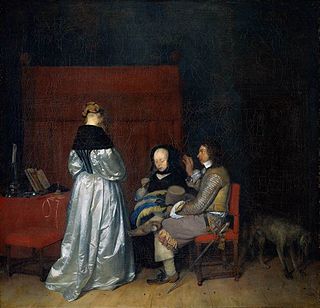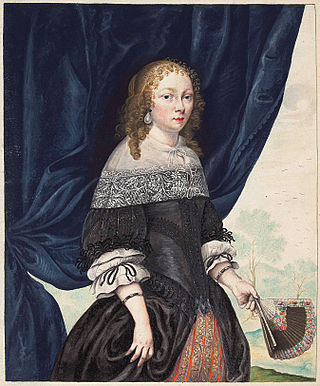
Gerbrand van den Eeckhout was a Dutch Golden Age painter and a favourite student of Rembrandt. He was also an etcher, an amateur poet, a collector and an adviser on art.

Gerrit Dou, also known as GerardDouw or Dow, was a Dutch Golden Age painter, whose small, highly polished paintings are typical of the Leiden fijnschilders. He specialised in genre scenes and is noted for his trompe-l'œil "niche" paintings and candlelit night-scenes with strong chiaroscuro. He was a student of Rembrandt.

Gerard van Honthorst was a Dutch Golden Age painter who became known for his depiction of artificially lit scenes, eventually receiving the nickname Gherardo delle Notti. Early in his career he visited Rome, where he had great success painting in a style influenced by Caravaggio. Following his return to the Netherlands he became a leading portrait painter. Van Honthorst's contemporaries included Utrecht painters Hendrick Ter Brugghen and Dirck van Baburen.

Gerard ter Borch, also known as Gerard Terburg, was a Dutch Golden Age painter mainly of genre subjects. He influenced his fellow Dutch painters Gabriel Metsu, Gerrit Dou, Eglon van der Neer and Johannes Vermeer. According to Arthur K. Wheelock Jr., Ter Borch "established a new framework for subject matter, taking people into the sanctum of the home", showing the figures' uncertainties and expertly hinting at their inner lives. His influence as a painter, however, was later surpassed by Vermeer.

Frans van Mieris the Elder, was a Dutch Golden Age genre and portrait painter. The leading member of a Leiden family of painters, his sons Jan (1660–1690) and Willem (1662–1747) and his grandson Frans van Mieris the Younger (1689–1763) were also accomplished genre painters.

The Wine Glass is an oil-on-canvas painting by Johannes Vermeer, created c. 1660, now in the Gemäldegalerie, Berlin. It portrays a seated woman and a standing man drinking in an interior setting.

The Gallant Conversation is an oil-on-canvas painting from circa 1654 by Gerard ter Borch. A late 18th century French print of the work is titled The Paternal Admonition, apparently believing it showed a father reprimanding his daughter, but modern art historians see it as a conversation between two prospective lovers, either a discussion of a betrothal or, more likely, a customer propositioning a prostitute in a brothel. There are two versions made by the painter, one at the Rijksmuseum, in Amsterdam, and the other at the Gemäldegalerie Berlin. The two paintings are dated to around 1654. The Amsterdam version is 71 cm by 73 cm, with the extra centimeters on the right being taken up by a dog and a door. The dimensions of the Berlin painting is smaller, 70 by 60 cm.

Marguerite Gérard was a French painter and printmaker working in the Rococo style. She was the daughter of Marie Gilette and perfumer Claude Gérard. At eight years old, she became the sister-in-law of Jean-Honoré Fragonard, and when she was 14, she went to live with him. She was also the aunt of the artist Alexandre-Évariste Fragonard. Gérard became Fragonard's pupil in the mid-1770s and studied painting, drawing and printmaking under his tutelage. Gérard and Fragonard created nine etchings in 1778. Historians currently believe Gérard was the sole artist of five of these etchings, since many have a duplicate created by her tutor Fragonard. More than 300 genre paintings, 80 portraits, and several miniatures have been documented to Gérard. One of her paintings, The Clemency of Napoleon, was purchased by Napoleon in 1808.

Lady Writing a Letter with her Maid is a painting by the Dutch artist Johannes Vermeer, completed in 1670–1671 and held in the National Gallery of Ireland, in Dublin, Ireland. The painting shows a standing woman seemingly acting as a messenger between the seated younger lady and her unseen lover.

Jan Verkolje or Johannes Verkolje was a Dutch painter, draughtsman and engraver. He is mainly known for his portraits and genre pieces of elegant couples in interiors and, to a lesser extent, for his religious and mythological compositions. He was a gifted mezzotint artist. Trained in Amsterdam, Verkolje spent his active professional career iLien Delft where he had access to powerful patrons.

Gesina ter Borch was a Dutch Golden Age watercolorist and draftswoman, whose work mostly consists of watercolor paintings in albums. Most of her work captured her observations of family life, current events, and fashionable people. In addition to the visual arts, Gesina wrote love poetry.

Woman Reading a Letter is an oil painting by Dutch artist Gabriël Metsu, created c. 1665–1667, shortly before his death. During his lifetime, under the Golden Age of Dutch painting, Metsu was a renowned painter, much better known than Vermeer. This painting is assumed to be a pair with Man Writing a Letter.

Jan Gildemeester Jansz. was a Dutch art collector.

The Musician (1662) is an oil on canvas painting by the Dutch painter Bartholomeus van der Helst. It is an example of Dutch Golden Age painting and is part of the collection of the Metropolitan Museum of Art.

Interior with a Man Reading a Letter and a Woman Sewing is an oil painting on canvas executed c. 1670–1674 by the Dutch artist Pieter de Hooch, now in the private Kremer Collection.

Portrait of Helen van der Schalcke or Helena van der Schalcke as a Child is an oil-on-panel painting by Dutch artist Gerard ter Borch, created c. 1648. The painting is held at the Rijksmuseum, in Amsterdam.

A Woman Playing the Theorbo-Lute and a Cavalier is an oil on wood painting by Dutch artist Gerard ter Borch the Younger, created c. 1658. The work depicts a young woman playing a theorbo while her lover looks on. The painting is in the collection of the Metropolitan Museum of Art, in New York.

Seated Girl in Peasant Costume is an oil-on-panel painting by Dutch artist Gerard ter Borch, created c. 1650. It is held in the Rijksmuseum, in Amsterdam.

The Letter is an oil on canvas painting by the Dutch artist Gerard ter Borch, created c. 1660-1665. The work is in the British Royal Collection. It was purchased by King George IV in 1814 from the collection of the British banker Sir Thomas Baring. Earlier, in 1805, it had been acquired by Baring's father, at a time when many Dutch paintings from the 17th century where being sold abroad.

The Concert is an oil on panel painting by the Dutch artist Gerard ter Borch, created c. 1673–1675. The work is held in the Gemäldegalerie, in Berlin.




















